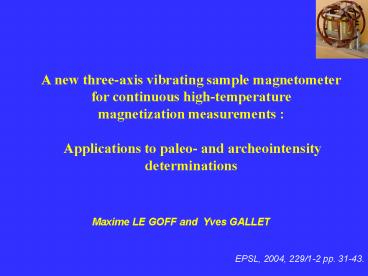Diapositive 1 - PowerPoint PPT Presentation
Title:
Diapositive 1
Description:
A new three-axis vibrating sample magnetometer for continuous high-temperature magnetization measurements : Applications to paleo- and archeointensity determinations – PowerPoint PPT presentation
Number of Views:50
Avg rating:3.0/5.0
Title: Diapositive 1
1
A new three-axis vibrating sample magnetometer
for continuous high-temperaturemagnetization
measurements Applications to paleo- and
archeointensity determinations
Maxime LE GOFF and Yves GALLET
EPSL, 2004, 229/1-2 pp. 31-43.
2
- Paleo- and archeointensity studiesare fastidious
and often unproductive - due to poor data quality
It is possible to make them fasterby measuring
the magnetizationat high temperatures
3
TRIAXE SENSOR
4
(No Transcript)
5
High-temperature version of the Thellier and
Thellier method revised by Coe
- must take into account the thermal dependence of
the spontaneous magnetization
6
High-Temperature Magnetization Measurements
Heating Troom to T1 (H0)
7
High-Temperature Magnetization Measurements
Heating T1 to T2 (H0)
8
High-Temperature Magnetization Measurements
Cooling to T1 andHeating T1 to T2 (H0)
9
High-Temperature Magnetization Measurements
Applying Hlab 70µT
10
High-Temperature Magnetization Measurements
Cooling T2 to T1 (H 70µT)
11
High-Temperature Magnetization Measurements
Hlab 0µT
12
High-Temperature Magnetization Measurements
Heating T1 to T2 (H0)
13
Two possibilities to derive intensity data
TRM
NRM
Remaining NRM (?1) and TRM (?5) fractions
between Ti and T2 ? R ratio
Lost NRM (?1) and TRM (?5) fractions between
T1 and Ti ? R ratio
R(Ti) Hlab ?1(Ti) / ?5(Ti) R(Ti) Hlab
?1(Ti) / ?5(Ti)
14
Test on a pseudo NRM acquired in a field of 50µT
in the same conditions as the laboratory TRM
(Hlab50 µT)
15
Ancient NRM R increasing, R much more constant
R, R (µT)
Ti, (C)
16
Cooling rate effect
R must be considered
17
Correction for the TRM anisotropy
18
Comparison between archeointensity data obtained
from the Thellier and Thellier method revised by
Coe and from the Triaxe
(Samples from Mesopotamia previously studied by
Genevey et al., JGR, 2003)
19
Selection criteria
- A large NRM fraction must be involved
- Expected behaviour of R and R curves
20
Example of rejected sample
21
Archeointensity results from a site of baked
bricks from Mesopotamia (Mari, Syria)
6 samples
22
Comparison between archeointensity results
obtained from the Thellier and Thellier and
Triaxe methods
H (µT)
Age (BC)
23
CONCLUSIONS
- The experimental procedure was successfully
tested with archeological baked materials.? We
need now to work on volcanic samples. - Other applications of the Triaxe - Viscosity
at high temperature.- Alteration.- Coupling
between different magnetic phases.- etc.
24
(No Transcript)
25
Remaining NRM (1) and TRM (5) between Ti and T2
? R ratio
Lost NRM (1) and TRM (5) between T1 and Ti ? R
ratio
R(Ti) Hlab ?1(Ti) / ?5(Ti) R(Ti) Hlab
?1(Ti) / ?5(Ti)
26
High-Temperature Magnetization Measurements
Cooling T2 to T1 (H0)































